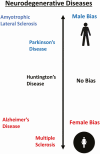Neurodegenerative Disease: Roles for Sex, Hormones, and Oxidative Stress
- PMID: 34467976
- PMCID: PMC8462383
- DOI: 10.1210/endocr/bqab185
Neurodegenerative Disease: Roles for Sex, Hormones, and Oxidative Stress
Abstract
Neurodegenerative diseases cause severe impairments in cognitive and motor function. With an increasing aging population and the onset of these diseases between 50 and 70 years, the consequences are bound to be devastating. While age and longevity are the main risk factors for neurodegenerative diseases, sex is also an important risk factor. The characteristic of sex is multifaceted, encompassing sex chromosome complement, sex hormones (estrogens and androgens), and sex hormone receptors. Sex hormone receptors can induce various signaling cascades, ranging from genomic transcription to intracellular signaling pathways that are dependent on the health of the cell. Oxidative stress, associated with aging, can impact the health of the cell. Sex hormones can be neuroprotective under low oxidative stress conditions but not in high oxidative stress conditions. An understudied sex hormone receptor that can induce activation of oxidative stress signaling is the membrane androgen receptor (mAR). mAR can mediate nicotinamide adenine dinucleotide-phosphate (NADPH) oxidase (NOX)-generated oxidative stress that is associated with several neurodegenerative diseases, such as Alzheimer disease. Further complicating this is that aging can alter sex hormone signaling. Prior to menopause, women experience more estrogens than androgens. During menopause, this sex hormone profile switches in women due to the dramatic ovarian loss of 17β-estradiol with maintained ovarian androgen (testosterone, androstenedione) production. Indeed, aging men have higher estrogens than aging women due to aromatization of androgens to estrogens. Therefore, higher activation of mAR-NOX signaling could occur in menopausal women compared with aged men, mediating the observed sex differences. Understanding of these signaling cascades could provide therapeutic targets for neurodegenerative diseases.
Keywords: AR45; angiotensin; estrogen; membrane androgen receptor; oxidative stress; testosterone.
© The Author(s) 2021. Published by Oxford University Press on behalf of the Endocrine Society. All rights reserved. For permissions, please e-mail: journals.permissions@oup.com.
Figures




References
-
- Barnham KJ, Masters CL, Bush AI. Neurodegenerative diseases and oxidative stress. Nat Rev Drug Discov. 2004;3(3):205-214. - PubMed
-
- 2020 Alzheimer’s disease facts and figures. Alzheimers Dement. 2020;16(3):391-460.
Publication types
MeSH terms
Substances
Grants and funding
LinkOut - more resources
Full Text Sources
Medical

